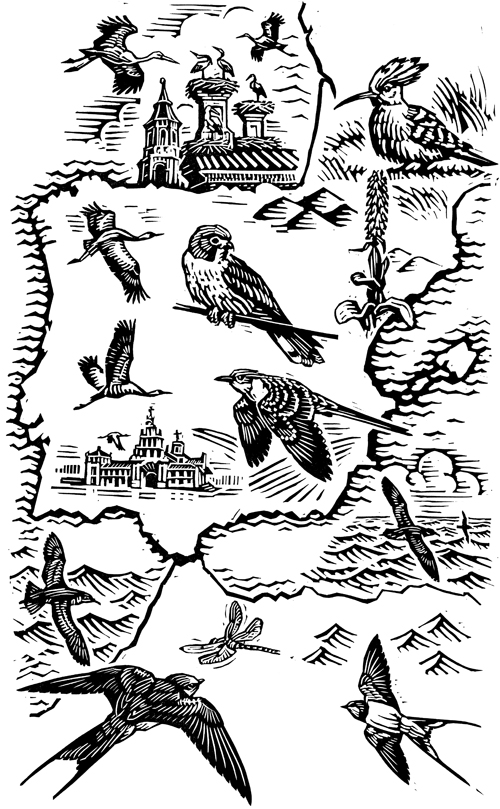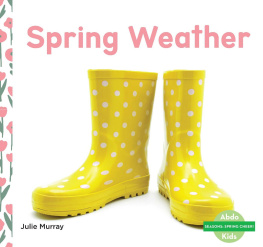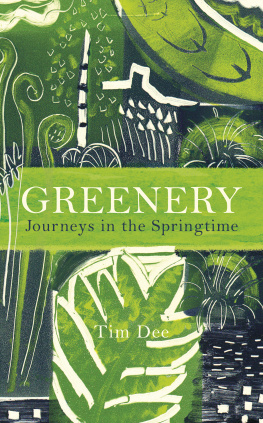
For Margaret Rose
in memory of Bernard Rose
(19272008)

Contents

1 February 2016, Ceuta. 35 54 N. Looking south from Monte del Renegado I see all of Africa like a map unscrolled stretching away into the glare.
What my eyes see is bounded by the Rif: Mount Boanan and its neighbours beyond Ttouan 30 miles to the south. In my mind, the view stretches past the limestone peaks to the burning sands of the Sahara, and beyond that, to the thin sanctuary of the Sahel. Unseen, but more than imaginary, it is something sensed. The Congo Basin sweats dark and fragrant before the great watershed at the threshold of the continents south. Farther still, beyond the sea fog where scorched Namib and icy Atlantic tryst; I see beyond the Okavango swamplands and southern savannas, all the way to the meadows of the Cape.
The dust and dews of Africa are bound into the flesh of 2 billion birds, now beginning their journeys to the lands to the north. They may be European by breeding, but they are African in make-up. Every sinew and muscle that propels them here, all the fat gained as fuel for the journey and most of the feathers of their aero-architecture, were replenished in Africa. The birds that end their days in some English field or Finnish aapa will bring a morsel of the rainforest to the northern soils, and their progeny will return it some future autumn. I look to the south as if to see into their eyes. I sense that a few of them may already be here perhaps swallows, thinly spread along these forested bluffs or strafing sheep flocks in Morocco, just beyond sight. The rest have yet to reach the valleys of the Atlas, most still to confront the thirsting wastes of the Sahara. In their hundreds of millions, they bedeck the acacias of Niger and Mali. Still more are irrupting out of the reed beds of the great deltas or plying northwards through the dripping canopies of Gabon and Cameroon.
Here, at the northern tip of the continent, the chill is lifting, and with it, the tang of herbs and goat shit, acrid and sweet and nostril-cloying, and dragonflies have appeared to ride the waves of rising air. I turn to face north, my gaze panning past the fog-white buildings of Ceuta and its bastion hillock Monte Hacho. With the sun behind me, I see across the Strait of Gibraltar all the cooler colours of Europe. This is instantly the difference between the two continents. Africa: white and platinum and etiolated purple; Europe: reflecting Africas sun in uncut sapphire and emerald. A strait separates them that today is the colour of denim, neither calm enough to return the suns glare in full nor rough enough to drag the blue of the ionosphere to its depths.
There are no early swallows today. But as the air warms, the handful of dragonflies becomes tens, then hundreds migrant hawkers, local in origin, but preparing to cross the Strait into Europe when the time comes, when wind direction and warmth allow. The patterns they describe around us are a kind of needlecraft, tatted among the white asphodels as if insect and flower were collaborating on some invisible lace frivolity.

We came here, Jane, Jos and I, along Arroyo de Calamocarro, a stony stream bed tucked into the cleavages of the lower slopes, through a forest of oleander, wild olive and cork oak. Jos, a native Ceut, has been keen to show off the local specialities, including African birds found nowhere else in Spain. He picked up a call from within a stand of giant reeds, a three-syllable trill, to my ears not unlike the chirrup of a budgerigar but with a mellow, thrush-like timbre.
Listen! Bulbul! The word is Persian, appropriated from an Arabic name for the unrelated nightingale, and adopted by the British and Spanish. The 130 or so bulbul species are found across Africa, the Middle East and Asia. This one, the garden bulbul Pycnonotus barbatus , called from behind us, across the narrow valley of the arroyo. We turned, but it proved elusive, hidden in a thicket of wild olive.
The empty stream made no sound but all around was a watery tinkling of serin song that seemed to occupy the vacant sonic niche. Several males were singing from their high perches into the natural amphitheatre of the lower Calamocarro. As if compelled by an uncontrollable ecstasy, their usual rapid, tinkling bell notes were hissed out at high pitch and speed, like a leak in a pressure valve. Focussing my binoculars on one, I saw what looked like a yellow plum, puffed to bursting point, twisting from side to side in a short arc to spread its jingles across the valley.
Herrerillo! announced Jos at the sight of a pair of birds, smaller even than the serins, crossing over our heads from a eucalyptus to a small trackside shrub. I was keen to see this bird because since my last visit to north-west Africa the genetics of the humble blue tit had been studied in detail. As long ago as 1841, Charles Lucien Jules Laurent Bonaparte (18031857), Prince of Canino and Musignano and a nephew of Napoleon, described the distinct race of blue tit that inhabited the farther shores of the Mediterranean. Bonaparte had fled to Rome as a child under the protection of Pope Pius VII, and there developed a passion for ornithology. After the fall of his uncle, he eventually settled in Philadelphia, where he worked on his four-volume book American Ornithology , in which many species are described scientifically for the first time. Among them is Chroicocephalus philadelphia , still known today as Bonapartes gull.
Bonaparte noticed what I was hoping to see a distinctly different-looking bird compared to the blue tit from home. As they moved in and out of view, as busy and curious as youd expect, I saw that their wings and back were a uniform ultramarine blue, and they sported dark caps that appeared black in the morning light. In size, behaviour and overall pattern, they were indistinguishable from the blue tit I know. But the colouring-in of the pattern pointed to a variety that has been separated from its European counterparts for a long time. In 2005, a group of American scientists led by Frank Gill coincidentally working at a university in Bonapartes Philadelphia analysed the birds DNA to work out exactly how the tit family evolved and what their taxonomic relationships were. The results were unexpected. They had all shared the scientific name Parus since Linnaeus coined it in 1758. Now it seems they are not so closely related after all, and the familiar set of garden species have been given new generic names. Parus is retained by the great tit, Parus major , while the little coal tit is now called Periparus . The blue tit is Cyanistes , from the Classical Greek kuanos , meaning dark blue. Then, in 2008, a team of molecular biologists from Germany and ornithologists from Tenerife studied Cyanistes in more detail, and found that the African and Canarian forms were genetically distinct enough from all the other blue tits in Europe to consider as a whole separate species: Cyanistes teneriffae , the African blue tit.

One continent, two flavours, says Jos, as we stand on the slightly domed roof of the fuerte, the semi-sunken fort, like a large pillbox, which marks the summit of Monte del Renegado. The death mask of Jebel Musa is not much more than a ravens call away to the west. Here they call the Jebel La Mujer Muerta (the dead woman). The double summit of her head and her breast; her closed eyes; the tear on her bony cheek; her perfectly proportioned nose, lips and chin; the dip of her neck; the clasped hands on her chest, raised at the top of her last breath: these are visible to the inhabitants of this enclave of Spain, but not to the Moroccans on whose soil she lies.
















